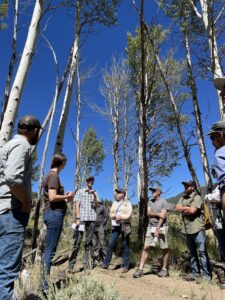
In this summary:
- About the Colorado Forest Collaboratives Network & Summit
- Agendas
- Summary of the 2023 Colorado Forest Collaboratives Summit
- Brief overview of each session
- Follow-up resources from each session (including presentation slides, where applicable)
- Field trip overview & packet
- Survey Feedback & Requests for Specific Follow-Up Resources
- Thank you’s!
Throughout this summary, you’ll find relevant follow-up resources in gold boxes.
About the Colorado Forest Collaboratives Network & Summit
From September 6-8th, 2023, approximately 100 collaborative leaders and partners gathered in Salida, Colorado for the 2023 annual Colorado Forest Collaboratives Summit. The creation of the Colorado Forest Collaboratives Network (CFCN) was inspired by successes at past Forest Collaboratives Summits, and Summit now represents the flagship annual event for the CFCN. To learn more about the CFCN, visit our webpage and/or join our mailing list.
This summary is intended to provide a very broad overview of speakers’ talks and resulting discussions, and to compile related resources.
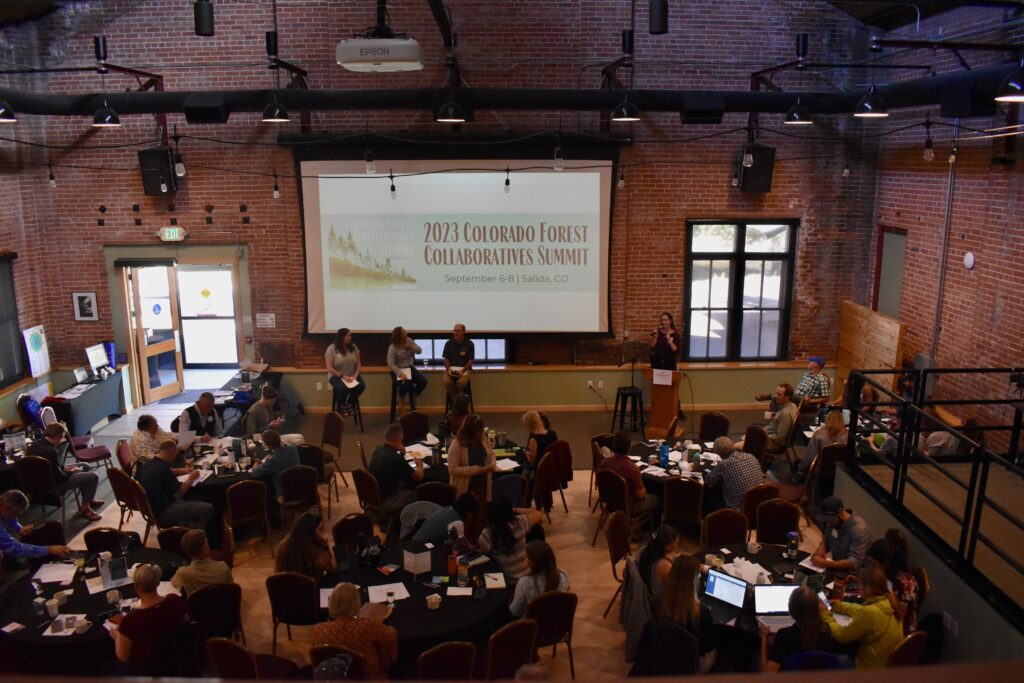
Registration List & Contact Info
Folks who attended Summit may contact CFCN Coordinator Katie McGrath Novak for a list of registrants & their contact info.
Agendas
Summary of the 2023 Colorado Forest Collaboratives Summit
Session 1 | Welcome to Summit!
Session objectives:
- Give Summit attendees glimpses into multiple local organizations and projects to establish a place-based connection to the area.
- Highlight local innovations & successes.
- Identify local points of contact and encourage networking.
We kicked off this year’s Summit with a warm welcome from three Salida-area locals. One of our goals this year was to establish a place-based connection to our Summit location and highlight local successes there. In our first session, we heard from Chaffee County Commissioner Greg Felt, Department of Natural Resources Wildfire Mitigation Program Administrator Alison Lerch, and Arkansas River Watershed Collaborative Executive Director Jonathan Paklaian. Each shared with us a brief overview of their own organization and a few exciting things they’re working on. Below are a couple of key points, plus follow-up resources.
Topic: Envision Chaffee County
Greg Felt, Chaffee County Commissioner
Commissioner Felt welcomed us to Chaffee County and shared a brief history and overview of one of the area’s well-known collaboratives, Envision Chaffee County.
Follow-ups and resources on Envision Chaffee County:
- 1-hour video: Cindy Williams presentation on Envision Chaffee County
This video was recommended as pre-work for Summit attendees and is a good resource for those who missed Commissioner Felt’s presentation, or those who saw it and are interested in seeing an even deeper dive into the effort. - Envision Chaffee County webpage
- View Commissioner Felt’s PowerPoint slides from Summit
Topic: Colorado Strategic Wildfire Action Program (COSWAP)
Alison Lerch, Wildfire Mitigation Program Administrator, CO Department of Natural Resources
Alison shared COSWAP updates, including a story of local success using Department of Corrections crews from the COSWAP grant to complete wildfire mitigation work in Lake County.
Follow-ups and resources related to COSWAP:
- COSWAP webpage & grant information
- COSWAP Branching Out presentation recording & other resources
Earlier this year, the Colorado Forest Collaboratives Network hosted a Branching Out session where Alison Lerch and Courtney Young shared COSWAP information, then opened up a listening session where they heard collaboratives’ recommendations for improving the grant in future years.
Topic: ARWC Overview & Successes
Jonathan Paklaian, Executive Director, Arkansas River Watershed Collaborative (ARWC)
Jonathan introduced us to ARWC, discussed the importance of nuanced science communication around wildfire and forestry efforts, and shared a few of the local successes that he is most looking forward to.
Follow-ups and resources related to ARWC:
- ARWC webpage
- Learn about ARWC’s Monarch Pass project – we almost visited this site on our field trip, but were not able to fit a 3rd stop. The nearly-500-acre project, completed in collaboration with many organizations including the US Forest Service, was innovative for its use of cut-to-length technology & steep-slope logging techniques.
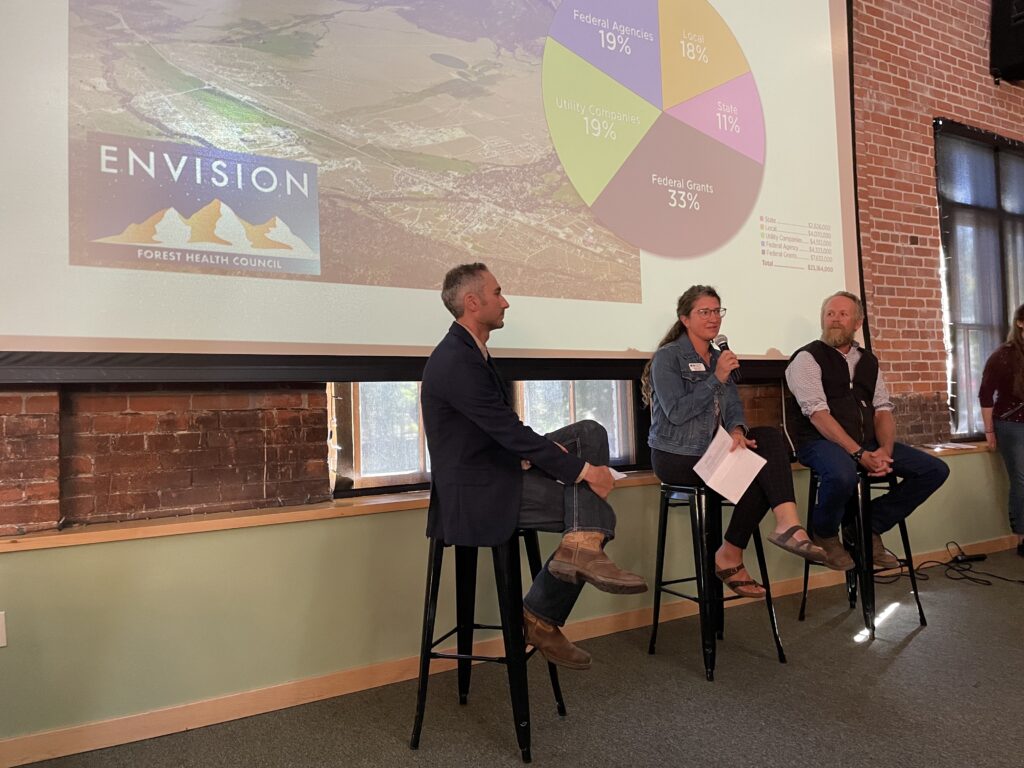
Topic: Welcome to the 2023 Colorado Forest Collaboratives Summit!
Katie McGrath Novak, Coordinator, Colorado Forest Collaboratives Network
Katie wrapped up our welcome session with lots of huge thank you’s to all who made Summit possible (see bottom of this summary), and a nod to Colorado State University’s Principles of Community, which we used as a guide for engagement throughout Summit.
Follow-ups and resources about the Colorado Forest Collaboratives Network:
- Learn more about the Colorado Forest Collaboratives Network (CFCN) at our webpage
- Be sure to join our mailing list to stay up-to-date with all the latest CFCN happenings! (if you registered for Summit, you’re already on the list).
- Join our monthly Branching Out series to learn & connect with collaborative leaders and partners from all across Colorado. You can also volunteer to lead a session or submit ideas for future sessions via our suggestion box.
Session 2 | Funding Innovations Across Local Contexts
Session objectives:
- Learn how local funding can be used as leveraging for larger state and federal opportunities.
- Identify ingredients for successful local funding initiatives.
- Reflect on how local context can affect initiatives.
One of the most common things we hear at the CFCN is that people need help with funding, and particularly with scaling up funding to achieve larger and larger goals. We know that this can look vastly different based on a number of community dynamics, so we wanted to highlight the process of scaling up funding in a couple of different ways.
Because these talked focused on processes, rather than specific funding mechanisms, we recommend the following resources for folks interested in learning about state funding initiatives:
- Read and/or watch: “CSFS Initiatives & Funding Opportunities” Slides | Recording
- Watch (30-mins): Chris Sturm presentation on Wildfire Ready Watersheds Program
We were pleased to have Tara Umphries (US Forest Service Program Manager for Shared Stewardship, Rocky Mountain Restoration Initiative, and Colorado Front Range Landscape Wildfire Crisis Strategy) facilitate this session for us.
Topic: The Southwest Wildfire Impact Fund (SWIF)
Ellen S. Roberts, Consultant & former Colorado legislator
Aaron Kimple, SWERI Program Director for Cross-Boundary Fire and Fuel Treatment Assessment and Application
Ellen and Aaron shared their experiences creating the Southwest Wildfire Impact Fund (SWIF) in their community. Their story started with the realization that wildfire mitigation money tends to go to densely populated areas, leaving more rural areas with fewer resources. Looking for ways to prove that their local community has some ‘skin in the game’ and is ready to engage and support wildfire mitigation, they created an initial vision, then allowed that vision to evolve over time according to local needs and preferences.
Follow-ups and resources related to the SWIF:
- Learn about SWIF, including design, implementation, and lessons learned, in this story map
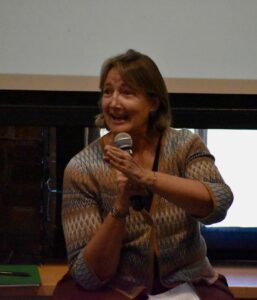
Topic: Boulder County Wildfire Mitigation Tax Measure
Paul Orbuch, Coordinator, Boulder County Fireshed
Meg Halford, Wildfire Team Forest & Grasslands Project Coordinator, Boulder County
Scott Golden, Resource Specialist for Forestry and fire, Boulder County Parks & Open Space
Paul, Meg, and Scott shared their experiences collaborating on a recent Boulder County wildfire mitigation tax measure. The tax measure, passed in November 2022 with a 72% approval rate, is used for forest and grassland wildfire risk mitigation projects, community programs to help residents prepare for wildfires, fire mitigation staffing, and more. Paul shared statistics comparing median incomes in counties that have managed to pass tax initiatives, noting that though it feels like a major hurdle, income does not have to be the determining factor in getting tax initiatives passed.
Follow-ups and resources about the Boulder County Wildfire Mitigation Tax:
- Read about the Boulder County Wildfire Mitigation tax measure, including full language from the measure, frequently asked questions, and a list of programs that the tax initiative will support, on this webpage
- Learn more about the Boulder County Fireshed
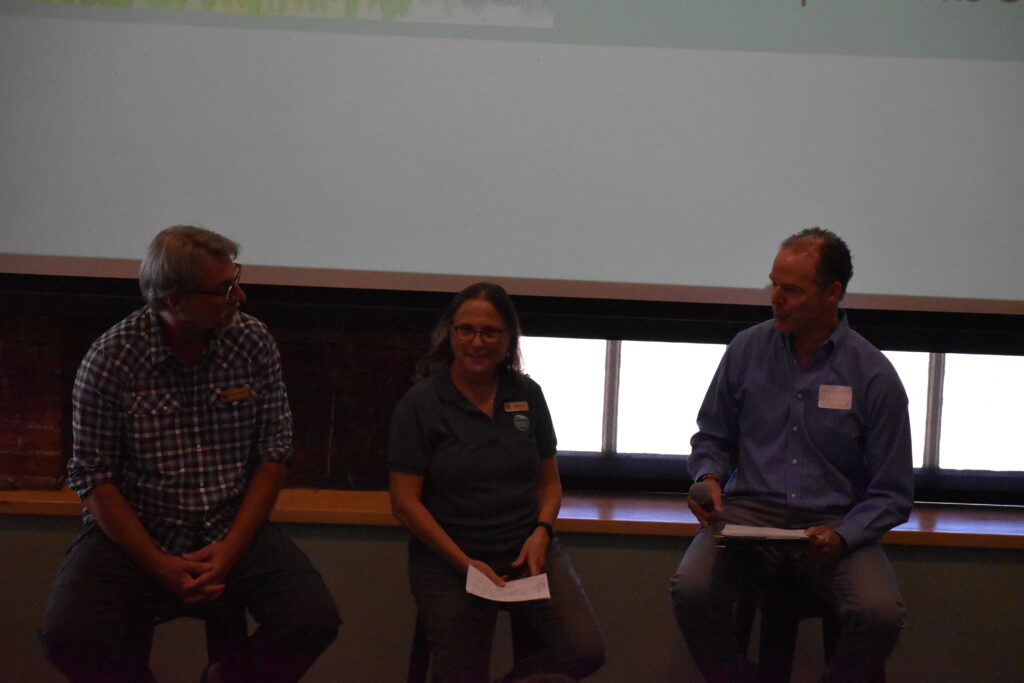
Following presentations from our speakers, we led into a break, where we asked folks to discuss at their tables: “What is one success you’ve had related to funding recently, and/or what is a challenge you’ve faced related to funding lately?” We asked participants to track their responses on sticky notes. Here are a few highlights that we heard:
Successes included:
- Falls Creek Ranch neighborhood wildfire mitigation near Durango: gave firefighters the leg up they needed to prevent the 416 fire from burning down homes in the neighborhood. Read more in this news article, which features quotes from one of our Summit attendees, Paulette Church.
- Several folks mentioned finding successes with matching funding. Example: Here is an article about an Upper Arkansas Forest Fund award in Chaffee County.
- West Region Wildfire Council was awarded county and state funding to offer wildfire mitigation and education.
- Several people were proud of the partnerships they’re building and the cross-boundary work those partnerships lead to.
- Securing funding for disadvantaged communities was also a repeated success story.
Challenges included:
- Funding for people vs. projects (capacity funding)
- Public outreach and public support; storytelling
- Reimbursements taking too long
- Lower-income communities or organizations not having the up-front funds to wait for reimbursement
- Lower-resourced communities and organizations not having personnel, time, other resources to write and manage grants
- Difficulty in getting funding for monitoring and maintenance of projects.
- Inconsistent risk modeling across grants
Are you involved in one of the success stories above? Are you in the midst of one of these challenges and want to brainstorm solutions? Do you have advice or experiences to share related to these topics? We’d love to have you on a Branching Out session! You can volunteer to share in our Suggestion Box.
Session 3 | State of the State: Agency leadership panel
Session objectives:
- Create opportunities for direct communication between agency leadership and place-based practitioners.
- Give brief agency updates relevant and specific to collaboratives.
Dan Gibbs, Director, Colorado Department of Natural Resources
Matt McCombs, Director and State Forester, Colorado State Forest Service
Jim Pitts, Deputy Supervisor, Pike-San Isabel National Forests and Cimarron & Comanche National Grasslands (filling in for Diana Trujillo, Forest Supervisor)
Next up, we had leadership from the Colorado Department of Natural Resources, Colorado State Forest Service, and US Forest Service share updates, followed by a Q&A where we asked Summit attendees to ask questions and share on-the-ground insights with leadership. Julie Shapiro, Senior Policy Director at Keystone Policy Center, did an excellent job moderating this session, keeping us on track and pulling key insights from a dense Q&A session.
Follow-ups & resources related to the leadership panel:
- DNR Summer Updates
- CSFS Quarterly Forest Health Council Update
- Colorado Forest Health Council 2023 Annual Report
- If you’re interested in learning more about the Colorado Forest Health Council (CFHC), you can check out the CFCN’s Keeping Up with the CFHC webpage for resources and tips. We will be hosting a Branching Out listening session with one or more CFHC council members and staff in early 2024 before the first quarterly CFHC meeting of the year.
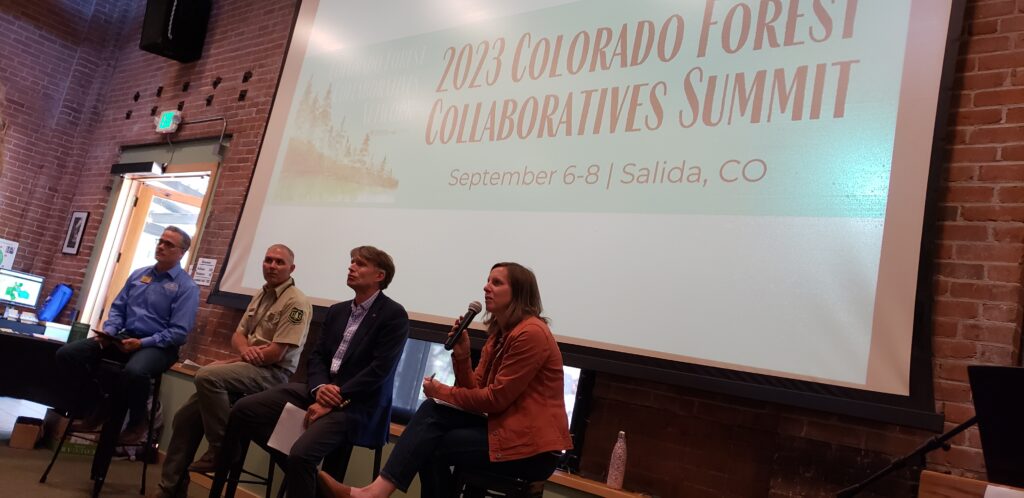
Session 4 | Navigating a complex landscape: Finding the right tool for the right time
Session objectives:
- Outline the process of navigating many available tools & choosing the one that best matches your organization and need.
- Understand users’ experiences of finding success in this process.
Topic: Clear Creek Watershed Pre-Wildfire Planning Study
Kerry Major, Chair, Clear Creek Watershed & Forest Health Partnership
Kerry shared a story of navigating a sea of tools and frameworks that exist for pre-wildfire planning. She shared that focusing on problem definition and evaluating tools based on how well they would address specific constraints helped identify components of tools that would best serve the Clear Creek Watershed & Forest Health Partnership. Ultimately, a combination of approaches from many different tools (listed below) was used to create the pre-wildfire plan.
Follow-ups and resources related to Clear Creek Watershed Pre-Wildfire Planning Study:
- Clear Creek Watershed Forest Health Partnership webpage
- Upper Clear Creek Watershed Pre-Wildfire Planning Study
- Project map (part-way down page, Kerry mentioned this in her talk)
- Frameworks considered in process:
- Wildfire Ready Watersheds Action Plan framework
- Colorado Geological Survey Debris Flow Hazard maps
- Colorado Wildfire Risk Assessment Portal: About
- Northern Colorado Fireshed Quantitative Risk Assessment
- Community Wildfire Protection Plans
- Clear Creek Watershed Plan
- Clear Creek Integrated Water Management Plan
Topic: Chaffee County Spatial Planning Tool
Brett Wolk, Assistant Director, Colorado Forest Restoration Institute
Brett shared his perspectives from working on the Chaffee County Community Wildfire Protection Planning effort. In this collaborative effort, a team from the Colorado Forest Restoration Institute adapted their Risk Assessment and Decision Support framework to create a map commonly referred to as Chaffee’s “bang for the buck map”.
Follow-ups and resources related to Chaffee County spatial planning tool:
- Risk Assessment Decision Support (RADS) in Chaffee County, Colorado: A Collaborative Process Case Study (2-page summary | Full report) – This report from the Colorado Forest Restoration details the planning process used in Chaffee County. It also details the “bang for the buck” map.
- The right work in the right places: Prioritizing fuels reduction to protect water supplies (as seen on screen during Brett’s presentation)
Topic: Tools for Landscape-Scale Monitoring on the Rio Chama CFLRP
Dana Guinn, Southwest Partnership Manager, Forest Stewardship Guild
Filling in for Esme Cadiente, (Southwest Region Director, Forest Stewards Guild) who was unable to join Summit due to unforeseen circumstances, Dana shared the process of navigating tools available for landscape-scale monitoring on the Rio Chama Collaborative Forest Landscape Restoration Project (CFLRP). She outlined the structured process through slides, linked below.
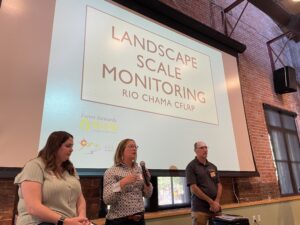
Follow-ups and resources related to landscape-scale monitoring on the Rio Chama CFLRP:
Field Trip to Poncha Pass & Riverside Projects
On Friday, we took a field trip to visit two cross-boundary forest management projects on the ground. The Poncha Pass Forest Restoration Project, led by the Colorado State Forest Service, took place across private and Bureau of Land Management jurisdictions. The project was designed to slow the spread of insects and mitigate wildfire risk around critical infrastructure including a major highway, a power line, homes, and businesses. You can learn more about the Poncha Pass project in the article, “Restoring Poncha Pass: Protecting Communities from Wildfire.”
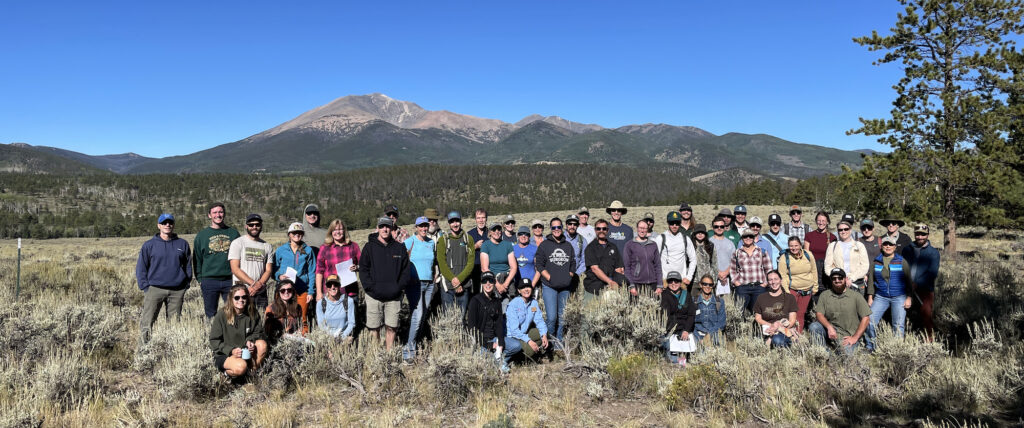
We then visited the Riverside Project north of Buena Vista. Led by Bird Conservancy of the Rockies and in partnership with the National Forest Foundation, this project also took place across both private and Bureau of Land Management lands. It was a multi-purpose project with a particularly strong emphasis on wildlife habitat enhancement. We visited two stops – at one, we chatted with a private landowner about his motivations for being a part of the project, and heard about the behind-the-scenes components of the project like funding and grant management. Then, we headed to a site where a thinning treatment had been completed fairly recently and heard about the technical components of the project.
Survey Feedback & Requests for Follow-Up Resources
At the end of this year’s Summit, we handed out surveys that we asked folks to fill out in exchange for a happy hour drink ticket. We received tons of thoughtful feedback that we can’t wait to incorporate into next year’s Summit – with feedback, we can make each year better and better! Below are some of the most common things we heard in our surveys.
Survey prompt: Please share two things that were good about this year’s Summit.
Common responses:
- Networking, relationship-building, & perspectives | By far the most common response to this question is that people were excited to build new relationships and strengthen existing ones through informal networking. People also noted that there was a wide range of expertise and perspectives in the room ranging including collaborative coordinators, utility company representatives, scientists, local and agency leadership, and more. At the CFCN, we were blown away by the massive uptick in registrations this year and are grateful to all attendees!
- Speaker lineup | We had a wide array of speakers including agency leadership, scientists, and place-based practitioners, and all worked hard to share meaningful presentations with us. Their hard work shone through; many people cited the speaker lineup as a key positive part of Summit. We cannot thank our fabulous speakers enough for sharing with us their stories and expertise!
- Topics | People shared that the topics addressed were timely and relevant. We thank our planning team for their work brainstorming and tailoring content.
- Logistics | Many people commented on the beautiful venue along the river, delicious local food, and the fact that this event was completely free to attend, making it accessible to organizations with limited resources. Thanks to our vendors, funders, and sponsors for making this possible!
Survey prompt: Please share two things that could have been better.
- More time for small group work, activities, and/or informal discussion | The primary area for improvement we heard in surveys is that the format of presentations felt a little repetitive, and there was a need to break up the dense lineup with more small group discussions, activities, and breaks. We hear this loud and clear and will certainly be incorporating this feedback into next year’s Summit.
- Venue felt crowded | People noted that the venue felt crowded for the size of the group. We exceeded our attendance expectations this year and will keep this in mind as we select venues for 2024.
- Missing perspectives | People were happy with the range of perspectives already at Summit, but there were also perspectives notably missing. In particular, this year’s Summit was missing indigenous perspectives and forest product industry perspectives. This is something we have been aware of at the CFCN at large since its beginning and seek to improve on an ongoing basis.

Survey prompt: Are there any follow-up conversations, resources, or connections you would like to see following the 2023 Summit?
Many of the requests we received have already been included throughout this report (for example, PowerPoint slides are linked in the main summary under the speaker that shared them). Here are a few of the additional requests we received:
- Attendee list and contact info | Folks who attended Summit may contact CFCN Coordinator Katie McGrath Novak for a list of all registrants & their contact info.
- Crystalize recommendations to Colorado Forest Health Council | In summer 2023, we hosted a listening session for collaboratives to share their recommendations for the Colorado Forest Health Council (CFHC). Katie McGrath Novak, CFCN Coordinator and collaboratives representative on the CFHC, then compiled recommendations and advocated for them in the CFHC’s two committees. We will host a similar listening session in early 2024 before the first quarterly meeting of the year. In the meantime, check out these resources:
- Colorado Forest Health Council 2023 Annual Report
- CFCN’s Keeping Up with the CFHC webpage
- CFCN 2023 Branching Out session, “CFHC Updates & Feedback from Forest Collaboratives”: Recording | Resources
- Scientific studies on forest management practices | A few folks asked for a sort of “one-stop-shop” for forest management and wildfire mitigation science. With so much research out there, a true one-stop-shop may not exist, but here are a few resources:
- Virtual engagement with the Colorado Forest Collaboratives Network | Check out our monthly Branching Out series! Each month we focus on a new topic relevant to collaboratives in Colorado. There is no obligation to show up every single month; please come when you can and be ready to engage. Also, be sure to follow our newsletter as we are always adding new opportunities.
- “Panning for Nuggets of Science Gold: Reframing Forestry & Wildfire Management Communication” (virtual presentation mentioned by Brett Wolk during the leadership panel) | Recording + Resources
Thank You!!
The 2023 Colorado Forest Collaboratives Summit was made possible thanks to contributions and hard work from so many great collaborators across Colorado. We would especially like to thank our Summit planning team, field trip planning team, speakers, and sponsors.
Summit Planning Team
- Esther Duke, Coalitions & Collaboratives
- Holly Gordon, Colorado Forest Collaboratives Network Intern
- Ch’aska Huayhuaca, Colorado Forest Restoration Institute
- Alison Lerch, Colorado Department of Natural Resources
- Paul Orbuch, Boulder County Fireshed
- Aireona Bonnie Raschke, Center for Collaborative Conservation
- Rebecca Samulski, Fire Adapted Colorado
- John Sanderson, Center for Collaborative Conservation
- Brett Wolk, Colorado Forest Restoration Institute
- Scott Woods, Colorado State Forest Service
Field Trip Planning Team
- Kyle Deschenes, Bird Conservancy of the Rockies
- Rob Fenwick, Bird Conservancy of the Rockies
- Damon Lange, Colorado State Forest Service
- Matt Nykiel, National Forest Foundation
- JT Shaver, Colorado State Forest Service
Speakers
- Natalie Allio, Central Colorado Conservancy
- Greg Felt, Chaffee County Commissioner
- Alison Lerch, Colorado Department of Natural Resources
- Jonathan Paklaian, Arkansas River Watershed Collaborative
- Katie McGrath Novak, Colorado Forest Collaboratives Network
- Tara Umphries, US Forest Service
- Ellen Stuart Roberts, Consultant
- Aaron Kimple, Southwest Ecological Restoration Institutes
- Paul Orbuch, Boulder County Fireshed
- Meg Halford, Boulder County
- Scott Golden, Boulder County Parks & Open Space
- Julie Shapiro, Keystone Policy Center
- Dan Gibbs, Colorado Department of Natural Resources
- Matt McCombs, Colorado State Forest Service
- Jim Pitts, US Forest Service
- Diana Trujillo, US Forest Service (was not able to attend)
- Kerry Major, Clear Creek Watershed and Forest Health Partnership
- Brett Wolk, Colorado Forest Restoration Institute
- Dana Guinn, Forest Stewards Guild
- Esme Cadiente, Forest Stewards Guild (was not able to attend)


